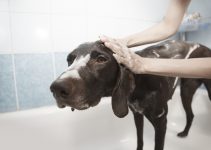This post may contain affiliate links. You can view our affiliate disclosure here.

Do you see dirt, mites, or discharge in your dog’s ears? They may be overdue for a cleaning.
In this article, we’ll tell you what you need to know about cleaning your dog’s ears. Find out the best ways to get rid of dirt and bacteria, and why dog ears are a haven for infections.
Why You Need To Clean Your Dog’s Ears
Your dog’s ears need regular cleaning to prevent wax, yeast, and bacteria buildup, which can lead to infection. Also, mites can feed on the wax in a dog’s ears.
The primary goal is to remove waste without irritating the eardrums.
Your dog’s ears (and whole body, for that matter) will need even more frequent cleaning if it is active. Swimming or constant rolling around in dirt increases the risk of problems within the ear.
You should also clean your dog’s ears more often if they are floppy. Big-eared dogs like Beagles, Basset Hounds, Labrador Retrievers, Golden Retrievers, and Spaniels have large ears which may impede airflow to the ear canal.

Note that a dog’s ear canal is more vertical than yours. It also has an L-shape and tends to retain fluid. This structure makes it susceptible to ear infections.
Dog owners should clean their dogs’ ears at least once a month, depending on their health.
Knowing When Your Dog’s Ears Need Cleaning
Make sure that your dog’s ears actually need cleaning before you start. Cleaning them too much may lead to irritation and infection.
You need to become acquainted with a healthy dog ear (it should be odorless, pink, and have no traces of dirt.). Clean it only when there is a visible change.
Some dogs’ ears will need minimal cleaning. Dogs which swim a lot need to have their ears cleaned often.
Veterinarians recommend keeping the ear canals well-ventilated and dry. A faint odor is a sign that your dog’s ears need cleaning.
If it smells like yeast and seems inflamed, seeks a veterinarian’s advice immediately because the dog could have an ear infection. Pay attention if your dog seems to shake its head frequently.
Causes Of Ear Infections In Dogs

Below are the most common causes of ear infections in dogs.
Note that cleaning an infected ear may worsen your dog’s condition, so it’s essential to be aware of these triggers.
Don’t clean your dog’s ears yourself if you notice an infection; instead, take it to the vet right away.
1. Fleas, Mites, & Ticks

Fleas, mites, and ticks are small but far from harmless. They can be a source of significant discomfort for dogs.
Your dog may have them if it has a blackish-brown, crusty ear.
2. Otitis Externa
Your dog may experience this condition, known as Otitis externa, if there is a reddish-brown discharge coming out of the ears.
It can be a result of too much ear wax, swimming, or bathing.
There may be a stench emanating from the ears, and the dog may also scratch or shake its head all the time.
In this case, your dog should get immediate attention from your vet. It’ll need an ear-cleaning solution, an antibiotic, or oral medication. If the problem recurs, surgery may be necessary.
3. Otitis Media
An untreated outer ear infection can lead to an infection of the inner ear.
Otitis media is an inflammation of the middle ear, and the signs are similar to those of Otitis externa.
Note that your dog may be unwilling to open its mouth because of the pain. Some dogs may also become nauseous.
The main treatment option for this is antibiotics. Your veterinarian may flush the infected ear or perform surgery in severe cases.
Gather Your Supplies
Proper cleaning of your dog’s ears requires preparation, and that means gathering the correct supplies. You will need:
1. Ear Cleaner
Look for an ear cleaner that veterinarians recommend. Do not use those that contain hydrogen peroxide or alcohol, because these chemicals may irritate the ears.
Seek a veterinarian’s advice if you are unsure if a solution is safe to apply on your dog’s ears.
2. Cotton Swabs

You can use these to swab the ridges of your dog’s outer ear.
Remember never to insert them directly into the ear canal, or you could cause hearing damage.
3. Tweezers
Use these to gently pull out wisps of hair from your dog’s ears. They are useful if your dog has hairy ears.
4. Towel
You will need this to clean up messes, which may happen if your dog is prone to shaking its head.
5. Treats
Dogs often get nervous when someone is touching them. Not only that, but pulling hair out of the ears can cause some pain.
Reward them with treats if they cooperate with you.
Natural Ear Cleaning Solutions
You don’t need to use an ear cleaner that costs an arm and a leg. You’ll also want to avoid the side effects of medication.
Natural solutions flush wax and bacterial debris out of the ear as well as medicated ones can, and are readily available.
1. Oregano Oil

This essential oil is an efficient ear cleaner and a suitable antibiotic. However, don’t use it undiluted, as this may cause more irritation.
Combine a drop of it with half an ounce of aloe vera juice, and swab your dog’s ear with the mixture.
2. Mullein
Mullein is potent because of its antibacterial properties. The recipe requires preparation.
- Combine Mullein leaves with olive oil in a jar and let the mixture rest for a few weeks.
- Warm it up and drop some of it into the infected ear canal. Swab the outer ear with it as well.
3. Apple Cider Vinegar
Apple cider vinegar makes an excellent cleaner; the acetic acid it contains removes debris quickly.
Note that you shouldn’t use vinegar if your dog’s ears are red, as it can worsen the condition.
- Combine the vinegar with distilled water.
- Either swab your dog’s ear with the solution or use a syringe.
- Remember to clean the ear flap with a cotton ball.
4. Calendula

Calendula is an often neglected herb, which is surprising because it has astounding antibacterial properties. You can use it to treat inner or outer ear infections.
- As you would with Mullein, pack Calendula leaves with olive oil in a jar.
- Add garlic for increased effectiveness and leave it for a few days.
- Warm it up and apply a few drops into your dog’s ears.
5. Coconut Oil
Coconut oil fights fungal and bacterial infection in the ears.
- Put two tablespoons of it in a saucepan and simmer until it liquefies.
- Place two drops of it into the affected ear. Do this for about a week.
How To Clean Your Dog’s Ears – 5 Steps
If you want to use one or more of the ear cleaners above, do the following to ensure thorough application.
- Get your dog into a sitting position, and then reward it. Allow your dog to sniff the cleaner if it wants.
- Lift the ear flap upright and fill the ear with the cleaner. Rub the bottom of the ear with your fingertips for about 20 seconds.
- Release your dog and allow it to shake its head. Wipe the solution away with a towel.
- Wipe the part of the outer ear and ear canal that you can see with a cotton swab.
- Give your dog a treat for cooperating.
If you’re using a veterinary-approved cleaner, watch this demonstration:
Conclusion
In all, ear cleaning is a relatively straightforward process, but you should be cautious and make sure you’re not doing anything that will harm your dog.
Use the suggestions above and try to make ear cleaning a positive routine.
Are you looking to clean your dog’s ears? Do you have any questions? Feel free to share your thoughts in the comments below!



